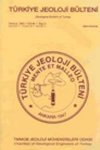
-
2024
-
2023
-
2022
-
2021
-
2020
-
2019
-
2018
-
2017
-
2016
-
2015
-
2014
-
2013
-
2012
-
2011
-
2010
-
2009
-
2008
-
2007
-
2006
- 2005
-
2004
-
2003
-
2002
-
2001
-
2000
-
1999
-
1998
-
1997
-
1996
-
1995
-
1994
-
1993
-
1992
-
1991
-
1990
-
1989
-
1988
-
1987
-
1986
-
1985
-
1984
-
1983
-
1982
-
1981
-
1980
-
1979
-
1978
-
1977
-
1976
-
1975
-
1974
-
1973
-
1972
-
1971
-
1970
-
1969
-
1968
-
1966
-
1964
-
1963
-
1961
-
1959
-
1958
-
1955
-
1954
-
1953
-
1952
-
1951
-
1950
-
1949
-
1948
-
1947
Abstract: Yozgat Batholith is exposed to the northernpart ofCentralAnatolia and represents the biggestfelsicplutonic body ofCentral Anatolian Crystalline Complex. The research area represents mainly by graniticandgabbroic rock units. The granitic rocks arepinkish in color and comprise the mainpartofthe area, whichare further differentiated in 3 subunits. These are, coarse crystalline biotite muscovite granite, finecrystalline biotite muscovite granite andfine crystalline muscovite granite with coarse quartz grains. Allthese subunits have transitional contactwith each other anddo not have any mafic microgranularenclaves.Microscopic studiesreveal that all the subunits ofthe granitic rocks are mainly compose ofquartz, Kfeldspar, mica andgarnetmineralswith differentproportions. Whole rock geochemistry reveals that granitic rock units are subalkaline magmatic rocks and arecalcalkaline in nature. Tectonic discrimination diagramsfor the granite rocks suggest that the granite ofnorthern part of Yozgat Batholith are within the syn-collision granite and ORG-normalized elementalpatternsfor all the subunits ofthe granite have similarpatterns which are characterized by enrichmentin LILwith respect to HFS elements.
Abstract: In thisstudy, organicgeochemical characteristics and depositional environments ofthe Tertiary agedoil shales in Beypazarı, Seyitömer, Himmetoğlu, Hatıldağ, Gölpazarı and Bahçecik areas (NW Anatolia)have been examined. The oil shales in all the studied areas have typically high HI and low 01 values. Pyrolysis/TOCanalysis results indicate that while Beypazarı, Himmetoğlu, Gölpazarı and Bahçecik oilshales contain onlyType I kerogen, Seyitömer and Hatıldağ contain dominantly type I but includes minor amounts of Type IIkerogen. Tmax valuesforthese oilshalesindicate that they are all immature.Result ofGCanalyses ofBeypazarı andSeyitömer oilshalesshow only Cl7 and n-alkanes but notshow other n-alkanes. Gas chromatograms ofHimmetoğlu, Hatıldağ, Gölpazarı and Bahçecik shalesshowabimodal distribution dominated with low number n-alkanes. Such a distribution indicates that these shalesare composedpredominantly ofalgea and minor amounts of terrestrial organic matter. Pr/Ph ratios oftheshales suggest that an anoxic depositional environmentfor the Beypazarı, Seyitömer and Hatıldağ shales,and a suboxic environmentforthe Himmetoğlu, Gölpazarı andBahçecikshales deposited.The biomarkerparameters calculated using m/z 217 and m/z 191 mass chromatograms obtained byGC-MS analysis indicate that the oil shales include immature organic matter. Gammacerane, a typicalbiomarkerforsaline depositional environment, has ben determinedfor all oil shales except thosefrom theBeypazarı area. When other biomarker parameters are taken in to account, it is apparent that all shalesdeposited in saline environments. In general, the data gained indicate lacustrine depositional environmentsforthe oilshales in all the studied areas. However, trace amounts ofC}() sterane found in only shalesfrom theSeytiömer area indicate marine input andsuggest lacustrine depositional environment that was occasionallyinundatedby the sea.
Abstract: Cora Maar, Kapadokya Volkanik Bölgesi, taban yayılım ürünleri, sedimanteryapılar, yığışım lapillisi, tane boyu analizi Cora Maar`(CM) is a monogenetic volcano located to the 20 km northwest ofMountErciyes, withinthe Cappadocian VolcanicProvince (CVP). Cora Maaris a typical example ofa maar-diatreme volcano witha nearly circular craterwith a mean diameterofc. 1.2 km. The CMcraterissurroundedby a well-beddedbasesurge tephra rim sequence up to 40 m in thickness. This sequence issubdivided in variousfacies dependingon the characteristics of the constituents. Having a D/d ratio of 12, Cora is a relatively mature maarcompared to recentmaar craters in the world.Cora crater is excavated within the andesitic lavaflows ofQuaternary age. The tephra sequence isnot indurated, andconsists ofjuvenile scoria clasts up to 70 cm, lithic clasts up to 130 cm, accretionary lapilliup to 1.2 cm in diameter, and ash-lapilli sized volcanic material. Accretionary lapilli are observed in almostevery level ofthe sequence, and classified as rim and core-type. Base surge layers display well-developedantidune structures indicating the direction ofthe transport. Bothprogressive and regressive dune structuresarepresentwithin the tephra sequence. Otherdepositionalstructures are impactsags andchannelstructures.Observed vertical and lateralfacies change in bedding style ofbase surge deposits can be explained by thedecrease ofthesurgeflowpower anddue to a decrease in suspended-loadtransportrate and/or an increase inbedload transportrate, respectively.Detailed sections were made bed by bedfrom 5 different locationsfrom CM tephra. These sectionswere measured and sampledfor granulometric analyses along a 400 m tephra profile 500, 750, 1000 mdistance from the crater. A total of 168 samples were sieved with mesh size ranging from
Abstract: Surface and groundwater quality ofMersin-Tarsus hillside and coastal aquifers extending betweenBerdan and Karakuz streams was investigated by means ofin-situ measurements and chemical analysesduring the years 2001-2002-2003. Groundwater`s temperature, pHand specific electrical conductivity arefound to range between 20-26 °C, 6.4-8.6 and 385-6890 microS/cm, respectively. In two hotwater wells,temperature, pH and specific electrical conductivity are between 38-40°C, 7.32-7.59 and 10900-12000microS/cm. Great majority ofgroundwatersamples belongs to Ca-HCO}facies though, MgHC03, NaHC03,NaCl, CaSO4 andNaSO4 type waterswere also observed. In considerable number ofsamples, nitrate exceedsdrinking water limits while, limited number ofsamplesposses Fe and Cd values above the limits. Seawaterintrusion is observed only in a fewsites.

 TMMOB
TMMOB